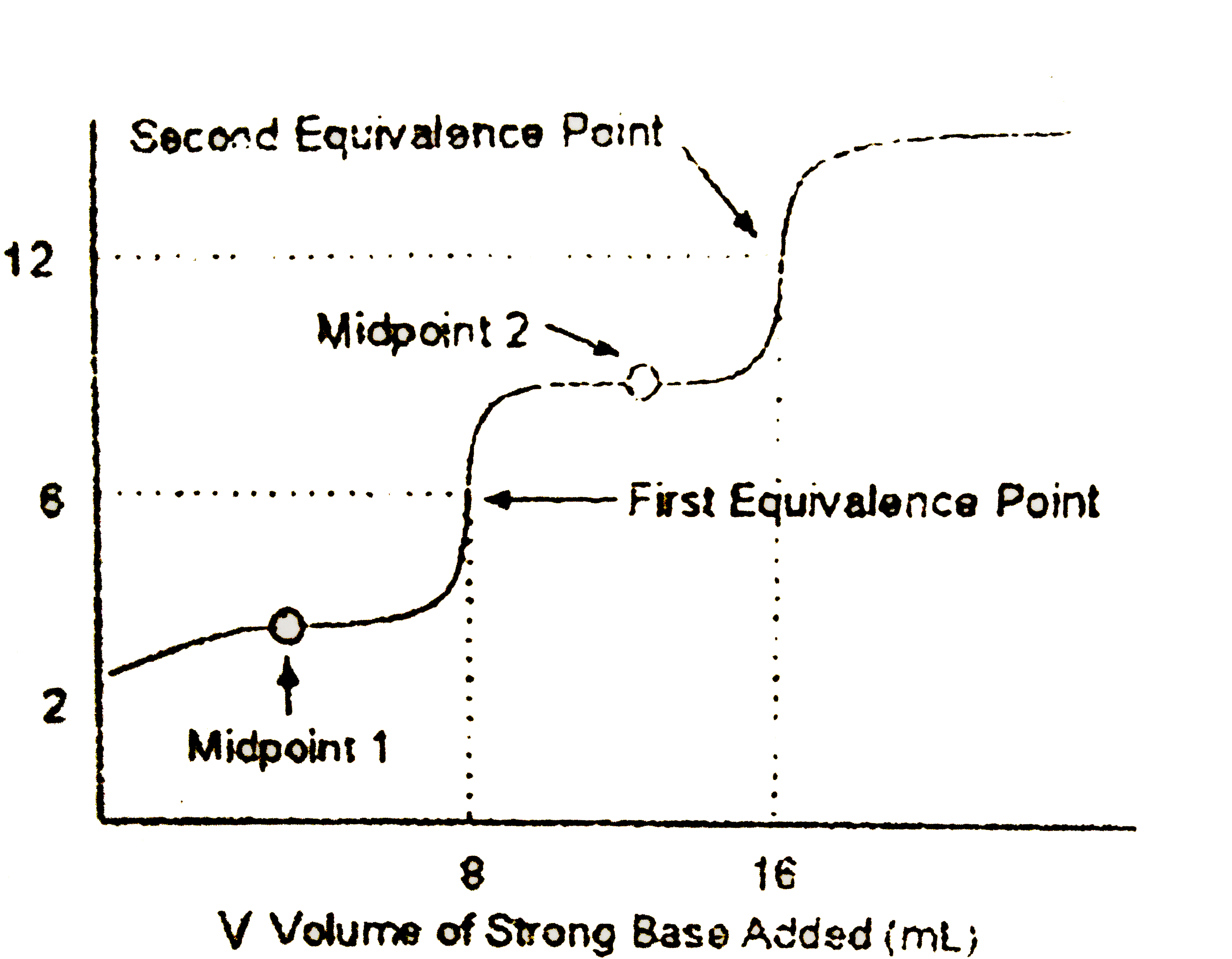A solution of strong acid/strong base of pH=x is mixed with equal volume of B should of strong acid/strong base of pH=(14−x) such that the resulting mixture has a pH=7. If only natural number values of x are allowed ,excluding x=−7 then how many possible values of x would be there? (Negative values of pH are not to be considered)
To solve the problem, we need to analyze the pH values of two solutions mixed together and how they relate to the resulting pH of the mixture.
1. Understanding pH Values:
- Let the pH of solution A be x.
- Then, the pH of solution B is 14−x.
- The resulting mixture has a pH of 7.
2. Calculating Hydrogen Ion Concentrations:
- The concentration of hydrogen ions (H+) in solution A is given by:
(H+)A=10−x
- The concentration of hydrogen ions (H+) in solution B is:
(H+)B=10−(14−x)=10x−14
3. Setting Up the Neutrality Condition:
- When mixed in equal volumes, the total concentration of hydrogen ions in the mixture must equal the concentration of hydroxide ions (OH−) for the solution to be neutral (pH = 7).
- At pH 7, (H+)=(OH−)=10−7.
4. Equating Concentrations:
- The total concentration of hydrogen ions from both solutions can be expressed as:
(H+)A+(H+)B2=10−7
- Substituting the expressions for (H+)A and (H+)B:
10−x+10x−142=10−7
5. Clearing the Fraction:
- Multiply both sides by 2:
10−x+10x−14=2×10−7
6. Rearranging the Equation:
- Rearranging gives:
10−x+10x−14=2×10−7
- This can be rewritten as:
10−x+10x1014=2×10−7
- Multiply through by 1014:
1014−x+10x=2×107
7. Finding Integer Solutions:
- Let y=10x. Then, the equation becomes:
1014y+y=2×107
- Rearranging gives:
1014+y2=2×107y
- This is a quadratic equation in y:
y2−2×107y+1014=0
8. Using the Quadratic Formula:
- The roots of the quadratic equation can be found using:
y=2×107±√(2×107)2−4×10142
9. Calculating the Discriminant:
- The discriminant simplifies to:
(2×107)2−4×1014=4×1014−4×1014=0
- This indicates that there is one unique solution for y.
10. Finding the Value of x:
- Since y=10x, we can find x from the unique solution of the quadratic equation.
11. Determining Natural Number Values:
- The only natural number values for x that satisfy the condition 1≤x≤6 are 1,2,3,4,5,6.
Final Count of Possible Values:
- The possible values of x are 1,2,3,4,5,6, which gives us a total of 6 possible values.
- Let the pH of solution A be x.
- Then, the pH of solution B is 14−x.
- The resulting mixture has a pH of 7.
- The concentration of hydrogen ions (H+) in solution A is given by:
(H+)A=10−x
- The concentration of hydrogen ions (H+) in solution B is:
(H+)B=10−(14−x)=10x−14
- When mixed in equal volumes, the total concentration of hydrogen ions in the mixture must equal the concentration of hydroxide ions (OH−) for the solution to be neutral (pH = 7).
- At pH 7, (H+)=(OH−)=10−7.
- The total concentration of hydrogen ions from both solutions can be expressed as:
(H+)A+(H+)B2=10−7
- Substituting the expressions for (H+)A and (H+)B:
10−x+10x−142=10−7
- Multiply both sides by 2:
10−x+10x−14=2×10−7
- Rearranging gives:
10−x+10x−14=2×10−7
- This can be rewritten as:
10−x+10x1014=2×10−7
- Multiply through by 1014:
1014−x+10x=2×107
- Let y=10x. Then, the equation becomes:
1014y+y=2×107
- Rearranging gives:
1014+y2=2×107y
- This is a quadratic equation in y:
y2−2×107y+1014=0
- The roots of the quadratic equation can be found using:
y=2×107±√(2×107)2−4×10142
- The discriminant simplifies to:
(2×107)2−4×1014=4×1014−4×1014=0
- This indicates that there is one unique solution for y.
- Since y=10x, we can find x from the unique solution of the quadratic equation.
- The only natural number values for x that satisfy the condition 1≤x≤6 are 1,2,3,4,5,6.
- The possible values of x are 1,2,3,4,5,6, which gives us a total of 6 possible values.
Topper's Solved these Questions
- IONIC EQUILIBRIUMBOOK - RESONANCE ENGLISHCHAPTER - IONIC EQUILIBRIUMEXERCISE - Part III One or more than one option correct type
16 Videos
- IONIC EQUILIBRIUMBOOK - RESONANCE ENGLISHCHAPTER - IONIC EQUILIBRIUMEXERCISE - Part IV Comprehension
8 Videos
- IONIC EQUILIBRIUMBOOK - RESONANCE ENGLISHCHAPTER - IONIC EQUILIBRIUMEXERCISE - Exercise 2 part I only one correct type
16 Videos
- HYDROCARBONBOOK - RESONANCE ENGLISHCHAPTER - HYDROCARBONEXERCISE - ORGANIC CHEMISTRY(Hydrocarbon)
50 Videos
- IUPAC NOMENCLATURE & STRUCTURAL ISOMERISM BOOK - RESONANCE ENGLISHCHAPTER - IUPAC NOMENCLATURE & STRUCTURAL ISOMERISM EXERCISE - Advanced Level Problems Part-5
2 Videos
Similar Questions
10mL of a strong acid solution of pH=2.000 are mixed with 990mL of another strong acid solution of pH=4.000. The pH of the resulting solution will be :
View Solution10 mL of a strong acid solution of pH=2.000 are mixed with 990mL of another strong acid solution of pH=4.000. The pH of the resulting solution will be:
View SolutionpH of a salt of a strong base with weak acid
View SolutionEnthalpy of neutralisation of all strong acids and strong bases has the same value because
View SolutionSolution A has a pH of 12, solution B has a pH of 4 and solution C has a pH of 3 which solution:
Is a strong acid
View SolutionEqual volumes of following solutions are mixed. In which case the pH of resulting solution will be average value of pH of two solutions?
View SolutionA solution of a substances is titrated against a strong base ( or acid ) ,volume V of strong base (or acid) is plotted against pH of the solution (as shown in figure) .The substances could be :

View SolutionA weak monobasic acid is half neutralized by a strong base. If the Ph of the solution is 5.4 its pKa is
View SolutionA strong acid is titrated with weak base. At equivalence point, pH will be :
View SolutionAt half - equivalence point in the titration of weak acid by a strong base , pH = …………..
View Solution
